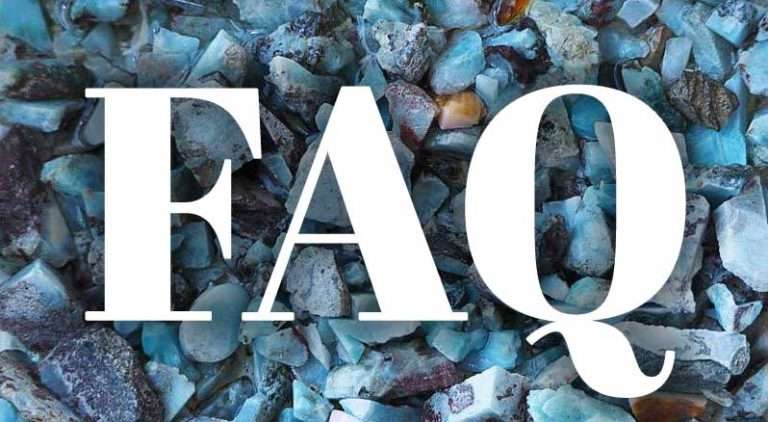On this page, you’ll find an exhaustive list of questions about the Larimar gemstone. You’ll find anything ranging historical information, stone coloration, location, mining process and much more!

What’s is so special about Larimar?
Larimar, with its distinctive aquatic color, is a water gem and is prized for bringing ocean-like calmness to the person who wears it. It also has metaphysical properties such as healing and other sought after qualities. The rareness of the gemstone is also another special trait since it can only be found in certain areas o the Dominican Republic
is Larimar a lucky stone?
Larimar is a rare blue variety of pectolite found only in the Dominican Republic. It’s named after the daughter of one of the first miners and is said to bring peace and serenity to its wearer. It’s commonly referred to as a “Dolphin Stone”, which later renamed to “Lucky Stone” based on a woman who met her soulmate and won a lottery!
Is Larimar man made?
Most of the gemstones you see on the market are natural, but due to recent interest in Larimar, there has been a rise in fake Larimar that is of less value and synthetically dyed to give the appearance of the beautifully ocean color of the gemstone. Also, Amazonite is sometimes sold off as Larimar, but the value is not comparable.
Does Larimar change color?
The Larimar gemstone does needs special care, like many other gemstones. If exposed to sunlight for too long, the coloration of the stone will fade over time. It also depends on the cleaning agent you use, which can affect the color. It’s best to wash it with plain water and a soft cloth.
Can Larimar go in the sun?
Larimar can change color, especially if it’s facing the sun for long periods of time. Be sure to keep it away from intense sunlight to help preserve the beautiful colors on the stone.
What does the name Larimar mean?
Local natives of the Dominican Republic believe the that gemstone came from the sea, so which they called it the blue stone. It was then later renamed to “Larimar” after Méndez combined his young daughter’s name Larissa and the Spanish word for sea (mar). The word was made to describe the colors of the Caribbean sea
Why is Larimar blue?
To better explain color mechanisms let us think of glacial ice. If the ice is thick, red wavelengths of light are absorbed, and the shorter blue wavelengths are transmitted (the ice appears blue).
If the ice is thin, all wavelengths are transmitted, thus it appears colorless, and these are examples of absorption. If the ice contains many air pockets (as snow does) the light can not penetrate and is reflected (appearing white), this scattering is known as the Rayleigh effect.
The sky is blue because particles in the atmosphere scatter the sun’s rays in the visible spectrum. The variation in color from zenith to horizon is due to varying concentrations of particles in the atmosphere.
It is possible that differences in the color of Larimar are the result of particles within the stone scattering different wavelengths of light.b
Does Larimar come in different colors?
Larimar is found in various shades of white, blue and green, with blue being the most desirable. There is a lot of variation in the intensity of color and it is very common to have small areas of deep blue color surrounded by pale white or green area’s.
It is fairly common to see hematite dendrites around the edges of some rocks and they are sometimes referred to as “red larimar”. While these pieces are very interesting and unusual, they are usually not used in the higher grades of jewelry quality stone.
You will also sometimes see “black larimar” this is not gem-quality material and is thought to be carbonized organic matter. It is soft and has no use so is usually thrown into the tailings along with the host rockand dirt.
Is Larimar Hard?
The hardness of larimar is from 4 to 7 on Mohs scale, depending on the crystalline structure of the stone.
Generally, the more intense blue and green specimens of larimar are the hardest, as they have the finest and densest needle structure. Larimar has been shown to be wearable every day, with simple gemstone bracelets, that have stood the test of everyday wear.
Is Larimar rare?
Larimar Deposits have been found in only one place in the world: a remote mountain range on the Island of Hispaniola. The surface area of the gemstone deposits are thought to cover less than a single square mile. There are single source stones on every continent and one of the most well known is Tanzanite, which is mined in the foothills of mount Kilimanjaro and covers an area of approximately 8 square kilometers.
Will Larimar increase in value?
One of the most beautiful and rare gemstones on the planet, larimar has only ever been found in one, very small area in the mountains of the Dominican Republic. Over the last decade, this Caribbean gemstone has become one of the most sought after semi-precious gemstones in the world.
Forty years ago, this blue rare gemstone was found on the surface. Twenty years ago it was mined in shallow pits 20 to 30’ deep. Now the mine shafts have to go more than 600 feet underground! As the larimar mines continue to chase the deposit ever deeper, the difficulty and cost to extract the stone will naturally increase. So it seems safe to say, that unless a new deposit is found, larimar is most likely to increase in value.
Is Larimar expensive?
As larimar becomes more known and as companies like Marahlago, continue to push the boundaries of what can be achieved, it is sure to increase in value. For instance, the Alexandria necklace takes 3-4 months and several kilo’s of larimar to make a single necklace. A piece of high-quality jewelry such as that has an incrementally different value than a simpler piece created with more rudimentary skills.
Every hundred feet farther into the ground, the miners have to dig makes this gemstone that much more difficult and costly to bring to the customer. There have been several price increases over the years, and it is realistic to think that the farther down the miners have to dig, the more expensive the stone will become.
How was Larimar formed?
It is thought that larimar was formed by super hot mineral rich fluid being forced into cracks and fissures formed by tectonic activity.
As the fluid in these cavities cooled, small crystalline nuclides called spherulites formed. As the fluid continued to cool the spherulites mixed and eventually coalesced into a gel which eventually hardened into Larimar.
Studies have shown that fine elongated needles indicate that rapid cooling occurred. However, the larger grains in the white areas indicate that more fluid entered the void and cooled at a slower rate.
The broken and bent needles at the interphase also provide evidence that the two different areas cooled at slightly different rates.
How is Larimar mined?
Forty years ago the deposit of larimar was on the surface, but over time that material has been mined out requiring the shafts to go deeper and deeper. The best quality larimar is often found in a layer between two different types of rocks, so the miners dig vertical shafts down until they hit this boundary layer and then start tunneling around looking for the veins of Larimar.



